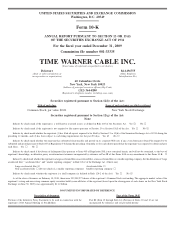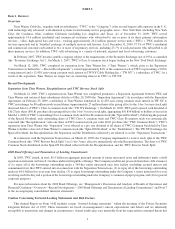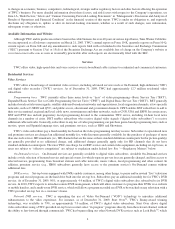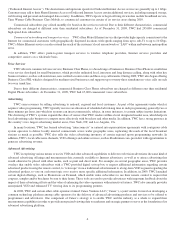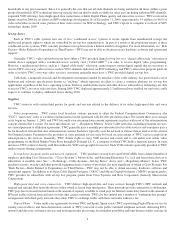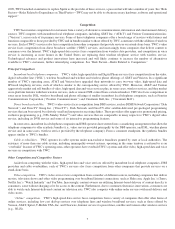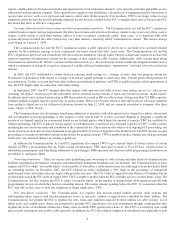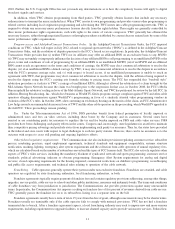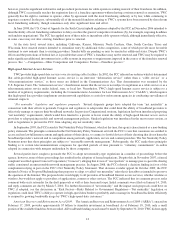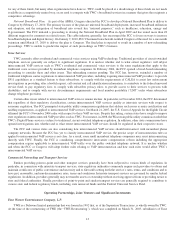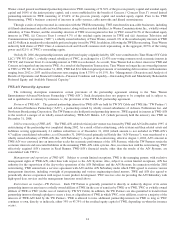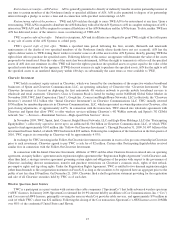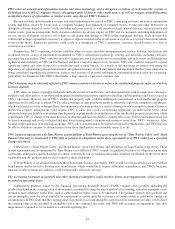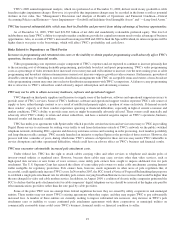Time Warner Cable 2009 Annual Report Download - page 21
Download and view the complete annual report
Please find page 21 of the 2009 Time Warner Cable annual report below. You can navigate through the pages in the report by either clicking on the pages listed below, or by using the keyword search tool below to find specific information within the annual report.signals, satellite-delivered broadcast networks and superstations, local origination channels, a few specialty networks and public access,
educational and government channels. This regulation also applies to the installation, sale and lease of equipment used by subscribers to
receive basic service, such as set-top boxes and remote control units. In the majority of its localities, TWC is no longer subject to rate
regulation, either because the local franchising authority has not become certified by the FCC to regulate these rates or because the FCC
has found that there is effective competition.
Carriage of broadcast television stations and other programming regulation. The Communications Act and the FCC’s regulations
contain broadcast signal carriage requirements that allow local commercial television broadcast stations to elect once every three years to
require a cable system to carry their stations, subject to some exceptions, commonly called “must carry,” or to negotiate with cable
systems the terms on which the cable systems may carry their stations, commonly called “retransmission consent.” The current carriage
cycle began on January 1, 2009.
The Communications Act and the FCC’s regulations require a cable operator to devote up to one-third of its activated channel
capacity for the mandatory carriage of local commercial television stations that elect “must carry.” The Communications Act and the
FCC’s regulations give local non-commercial television stations mandatory carriage rights, but non-commercial stations do not have the
option to negotiate retransmission consent for the carriage of their signals by cable systems. Additionally, cable systems must obtain
retransmission consent for all “distant” commercial television stations (i.e., those television stations outside the designated market area to
which a community is assigned) except for commercial satellite-delivered independent “superstations” and some low-power television
stations.
In 2005, the FCC reaffirmed its earlier decision rejecting multi-casting (i.e., carriage of more than one program stream per
broadcaster) requirements with respect to carriage of broadcast signals pursuant to must-carry rules. Certain parties filed petitions for
reconsideration. To date, no action has been taken on these reconsideration petitions, and TWC is unable to predict what requirements, if
any, the FCC might adopt in connection with multi-casting.
In September 2007, the FCC adopted rules that require cable operators that offer at least some analog service (i.e., that are not
operating “all-digital” systems) to provide subscribers down-converted analog versions of must-carry broadcast stations’ digital signals.
In addition, must-carry stations broadcasting in HD format must be carried in HD on cable systems with greater than 552 MHz capacity;
standard-definition signals may be carried only in analog format. These rules became effective after the broadcast television transition
from analog to digital service for full power television stations on June 12, 2009, and are currently scheduled to terminate after three
years, subject to FCC review.
The Communications Act also permits franchising authorities to negotiate with cable operators for channels for public, educational
and governmental access programming. It also requires a cable system with 36 or more activated channels to designate a significant
portion of its channel capacity for commercial leased access by third parties, which limits the amount of capacity TWC has available for
other programming. The FCC regulates various aspects of such third-party commercial use of channel capacity on TWC’s cable systems,
including the rates and some terms and conditions of the commercial use. These rules are the subject of an ongoing FCC proceeding, and
recent revisions to such rules are stayed pursuant to an appeal in the U.S. Court of Appeals for the Sixth Circuit. The FCC also has an open
proceeding to examine its substantive and procedural rules for program carriage. TWC is unable to predict whether any such proceedings
will lead to any material changes in existing regulations.
In addition, the Communications Act and FCC regulations also require TWC to give various kinds of advance notice of certain
changes in TWC’s programming line-up. Under certain circumstances, TWC must give as much as 30 or 45 days’ advance notice to
subscribers, programmers and franchising authorities of such changes. DBS operators and other non-cable programming distributors are
not subject to analogous duties.
Ownership limitations. There are various rules prohibiting joint ownership of cable systems and other kinds of communications
facilities, including local telephone companies and multichannel multipoint distribution service facilities. The Communications Act also
requires the FCC to adopt “reasonable limits” on the number of subscribers a cable operator may reach through systems in which it holds
an ownership interest. In December 2007, the FCC adopted an order establishing a 30% limit on the percentage of nationwide
multichannel video subscribers that any single cable provider can serve. The U.S. Court of Appeals for the District of Columbia Circuit
reversed and vacated the FCC order in August 2009. TWC is unable to predict when the FCC will take action to set new limits, if any. The
Communications Act also requires the FCC to adopt “reasonable limits” on the number of channels that cable operators may fill with
programming services in which they hold an ownership interest. The matter remains pending before the FCC. It is uncertain when the
FCC will rule on this issue or how any regulation it adopts might affect TWC.
Pole attachment regulation. The Communications Act requires that investor-owned utilities provide cable systems and
telecommunications carriers with non-discriminatory access to any pole, conduit or right-of-way controlled by those utilities. The
Communications Act permits the FCC to regulate the rates, terms and conditions imposed by these utilities for cable systems’ use of
utility poles and conduit space. States are permitted to preempt FCC jurisdiction over pole attachments through certifying that they
regulate the terms of attachments themselves. Many states in which TWC operates have done so. The FCC or a certifying state could
increase pole attachment rates paid by cable operators. In addition, the FCC has adopted a higher pole attachment rate applicable to pole
9


